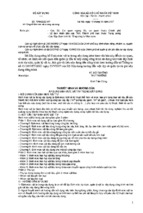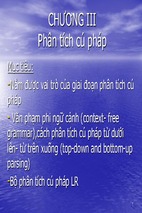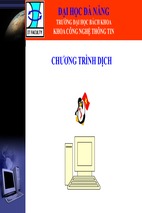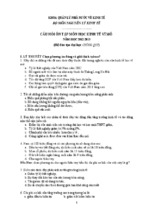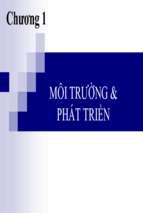TLFeBOOK
HOTEL FRONT OFFICE MANAGEMENT
TLFeBOOK
TLFeBOOK
HOTEL FRONT OFFICE MANAGEMENT
THIRD EDITION
James A. Bardi, Ed.D., CHA
The Pennsylvania State University
John Wiley & Sons, Inc.
TLFeBOOK
This book is printed on acid-free paper. ∞
Copyright © 2003 by John Wiley & Sons, Inc. All rights reserved
Published by John Wiley & Sons, Inc., Hoboken, New Jersey
Published simultaneously in Canada
No part of this publication may be reproduced, stored in a retrieval system or transmitted in any form or
by any means, electronic, mechanical, photocopying, recording, scanning, or otherwise, except as
permitted under Section 107 or 108 of the 1976 United States Copyright Act, without either the prior
written permission of the Publisher, or authorization through payment of the appropriate per-copy fee to
the Copyright Clearance Center, Inc., 222 Rosewood Drive, Danvers, MA 01923, (978) 750-8400, fax
(978) 750-4470, or on the web at www.copyright.com. Requests to the Publisher for permission should be
addressed to the Permissions Department, John Wiley & Sons, Inc., 111 River Street, Hoboken, NJ 07030,
(201) 748-6011, fax (201) 748-6008, e-mail:
[email protected].
Limit of Liability/Disclaimer of Warranty: While the publisher and author have used their best efforts in
preparing this book, they make no representations or warranties with respect to the accuracy or
completeness of the contents of this book and specifically disclaim any implied warranties of
merchantability or fitness for a particular purpose. No warranty may be created or extended by sales
representatives or written sales materials. The advice and strategies contained herein may not be suitable
for your situation. You should consult with a professional where appropriate. Neither the publisher nor
author shall be liable for any loss of profit or any other commercial damages, including but not limited to
special, incidental, consequential, or other damages.
For general information on our other products and services or for technical support, please contact our
Customer Care Department within the United States at (800) 762-2974, outside the United States at (317)
572-3993 or fax (317) 572-4002.
Wiley also publishes its books in a variety of electronic formats. Some content that appears in print may not be
available in electronic books.
Library of Congress Cataloging-in-Publication Data:
Bardi, James A.
Hotel front office management/ James A. Bardi.—3rd ed.
p. cm
ISBN 0-471-01396-X (cloth : alk. paper)
1. Hotel Management. I. Title
TX911.3.M27 B35 2003
647.94'068—dc21
2002024087
Printed in the United States of America
10 9 8 7 6 5 4 3 2 1
TLFeBOOK
To Linda
Your love and encouragement made this book possible.
and
Maria, Ryan, and David
The joy of sharing this book with you makes it all worthwhile.
TLFeBOOK
TLFeBOOK
Contents
Preface
ix
Acknowledgments
xi
Chapt e r 1
Introduction to Hotel Management
1
Chapt e r 2
Hotel Organization and the Front Office Manager
33
Chapt e r 3
Effective Interdepartmental Communications
71
Chapt e r 4
Property Management Systems
93
Chapt e r 5
Reservations
127
Chapt e r 6
Yield Management
161
Chapt e r 7
Guest Registration
181
Chapt e r 8
Processing Guest Charge Payments
221
Chapt e r 9
Guest Checkout
237
Chapt e r 10
Night Audit
261
Chapt e r 11
Managing Hospitality
305
Chapt e r 12
Training for Hospitality
333
Chapt e r 13
Promoting In-House Sales
359
Chapt e r 14
Security
379
Glossary
409
Index
425
TLFeBOOK
TLFeBOOK
Preface
T
he third edition of Hotel Front Office Management continues to address the demands
of the hotel industry in the new millennium. Educators who are preparing professionals for roles as front office managers and general managers in hotels are required to meet
the challenges of operations, technology, training, empowerment, and international applications. This edition continues to encourage students to take an active role in applying
these concepts to the exciting world of hotel operations.
The emphasis on management continues to play a central role in this third edition.
The structure presented in this text will assist students as they prepare for positions as
entry-level managers. The logical presentation of chapters in order of operations—overview of lodging hospitality, tour of the front office, review of the guest cycle, and analysis
of guest services—will allow students to gain insight into a front office manager’s role in
the hotel.
The “Front Office Essentials” chapter from the second edition has been deleted because
a majority of hotels employ a property management system as opposed to a manual front
office operation. Those portions of the chapter that referred to a property management
system are included in the new Chapter 4, “Property Management Systems.”
The third edition contains updated pedagogical features, including an “Opening Dilemma,” which presents students with a mini–case study problem to solve with the help
of material presented in the chapter; a “Solution to Opening Dilemma” is included at the
end of each chapter. “Hospitality Profiles”—commentaries from hotel front office managers, general managers, and other department managers in hotels—add an extra human
relations element to the text. “International Highlights”—articles of interest that accentuate the international workforce and international career opportunities for graduates—
provide a forum for professors and students to discuss this aspect of hotel management.
“Frontline Realities” includes unexpected yet very predictable situations. Students are
asked to discuss those situations and develop methods for handling them. More “Case
Studies” have been added to each chapter, allowing students to apply theory. A glossary
TLFeBOOK
x
PREFACE
of terms has been included, summarizing terms introduced in each chapter (which appear
in boldface in the text).
The author is very pleased to have the opportunity for instructors and students to use
instructional software with this text. Dr. Sheryl Fried Kline of Purdue University and
William Sullivan of Widener University and University of Delaware have prepared an
excellent new book and CD-ROM package, Hotel Front Office Simulation: A Workbook
and Software Package (New York: John Wiley & Sons, 䉷 2003) (ISBN 0-471-20331-9).
This simulation has been reflected in chapters dealing with reservations, registrations,
customer service, posting, and the night audit. This combination of the third edition of
Hotel Front Office Management and Kline and Sullivan’s software simulation will allow
hospitality professors to offer their students an optimal learning opportunity.
A completely revised instructor’s manual is available for the third edition for qualified
adopters of the book. Please contact your Wiley sales representative for details.
Will you like the third edition of Hotel Front Office Management? I think you will,
and I would appreciate hearing your comments (
[email protected]).
My very best to the future professionals of the hotel industry.
TLFeBOOK
Acknowledgments
T
he author wishes to acknowledge the following professors who provided insightful
reviews of individual chapters of this and previous editions. Without your concern
and thoughtful commentary, this effort for our students would not have been possible:
Thomas Jones, University of Nevada at Las Vegas; Robert McMullin, East Stroudsburg
State University; and James Reid, New York City Technical College.
I would like to express my appreciation to the following hospitality professionals who
provided commentary for the Hospitality Profiles included in this third edition: Dulcie
Baker, director of sales, Tide Water Inn, Easton, Maryland; Kevin Corprew, director of
rooms operation, Marriott, Overland Park, Kansas; Michael DeCaire, food and beverage
manager, Houston Hilton, Houston, Texas; Doug Gehret, director of rooms, Waldorf⫽
Astoria, New York City; Charles Gellad, general manager, Homewood Suites, Alexandria,
Virginia; Greg Goforth, general manager, Best Western Merry Manor, South Portland,
Maine; James Heale, controller, Sheraton Reading Hotel, Wyomissing, Pennsylvania; Lee
Johnson, director of corporate sales, Pier 5 Hotel and Brookshire Suites, Inner Harbor,
Baltimore, Maryland; John Juliano, director of safety and security, Royal Sonesta Hotel,
Cambridge, Massachusetts; Eric Long, general manager, Waldorf⫽Astoria, New York,
New York; Joseph Longo, general manager, The Jefferson Hotel, Richmond, Virginia;
Patrick Mene, vice president of quality, The Ritz-Carlton Hotel Company, L.L.C.; Thomas Norman, C.H.A., general manager, Holiday Inn Grenada, Grenada, Mississippi;
Randy Randall, general manager, Eldorado Hotel, Santa Fe, New Mexico; Todd Sheehan,
managing partner, Lincoln Plaza Hotel & Conference Center, Reading, Pennsylvania; and
Mike Schofield, general manager, Holiday Inn Express, Salem, Oregon.
One additional acknowledgment is offered to Dr. Trish Welch of Southern Illinois
University, who was instrumental in the first edition of Hotel Front Office Management.
Her words of support to Van Nostrand Reinhold for the initial prospectus and sample
chapter are still greatly appreciated.
TLFeBOOK
TLFeBOOK
C H A P T E R
1
Introduction to Hotel Management
OPENING DILEMMA
CHAPTER FOCUS POINTS
• Historical overview of the
A hospitality career fair is scheduled at the end of the week at your college or
university. Your recent review of this chapter has enticed you to explore the
hotel industry
• Hotel classification system
• Trends that foster growth
career opportunities in limited-service and full-service hotels. Your instructor
and employment in the
hotel industry
has asked you to prepare a list of possible questions to ask the recruiter. What
• Career development
would you include in that list?
The mere mention of the word hotel conjures up exciting images: a busy lobby filled with
international dignitaries, celebrities, community leaders, attendees of conventions and
large receptions, businesspersons, and family vacationers. The excitement that you feel
in a hotel lobby is something you will have forever in your career. Savor it and enjoy it.
It is the beginning of understanding the concept of providing hospitality to guests. As
you begin to grasp the principles of a well-operated hotel, you will discover the important
role the front office plays in keeping this excitement intact.
The front office is the nerve center of a hotel property. Communication and accounting
are two of the most important functions of a front desk operation. Effective communications—with guests, employees, and other departments of the hotel—are paramount in
projecting a hospitable image. Answering guest inquiries about hotel services and other
guests, marketing and sales department requests for information on guest room availability, and housekeeping department inquiries concerning guest reservations are but a
few of the routine tasks performed almost constantly by a hotel front desk in its role as
communications hub. Accounting procedures, involving charges to registered and non-
TLFeBOOK
2
CHAPTER 1: INTRODUCTION TO HOTEL MANAGEMENT
registered hotel guest accounts, are also very important in the hospitality field. Itemized
charges are necessary to show a breakdown of charges if a guest questions a bill.
Services for which fees are charged are available 24 hours a day in a hotel property.
Moreover, because guests may want to settle their accounts at any time of the day, accounts must be current and accurate at all times. Keeping this data organized is a top
priority of good front office management.
Founders of the Hotel Industry
A history of the founders of the hotel industry provides an opportunity to reflect upon
our heritage. Learning about the founding giants such as Statler, Hilton, Marriott, Wilson,
and Schultz, to name a few, allows a student of the hotel industry to discover the interesting lineage of hoteliers. The insights afforded by the efforts of these innovators who
carved out the modern hotel industry may help future professionals with their own career
planning.
E. M. Statler
To begin to understand the history of the modern hotel industry, let’s look at some of
the forerunners in the industry who were entrepreneurs motivated by wealth and fame
on a grand scale.1 Ellsworth M. Statler (1863–1928) developed the chain of hotels that
were known as Statlers. He built and operated a hotel in Buffalo, New York, at the PanAmerican Exposition of 1901. Among his hotels were ones located in Boston, Cleveland,
Detroit, New York City, and St. Louis. In 1954, he sold the Statler chain of hotels to
Conrad Hilton.2
Statler devised a scheme to open an incredible two-story, rectangular wood structure that would contain 2,084 rooms and accommodate 5,000 guests. It was to be
a temporary structure, covered with a thin layer of plaster to make it appear substantial, although simple to tear down after the fair closed.3
Conrad Hilton
Conrad Hilton (1887–1979) became a successful hotelier after World War I, when he
purchased several properties in Texas during its oil boom. In 1919, he bought the Mobley
Hotel in Cisco, Texas. In 1925, he built the Hilton Hotel in Dallas, Texas.4 His acquisitions during and after World War II included the 3,000-room Stevens Hotel (now the
Chicago Hilton) and the Palmer House in Chicago and the Plaza and Waldorf⫽Astoria
in New York City. In 1946, he formed the Hilton Hotels Corporation, and in 1948, he
formed the Hilton International Company, which came to number more than 125 hotels.5
With the purchase of the Statler chain in 1954, Hilton created the first major chain of
modern American hotels, that is, a group of hotels all of which follow standard operating
TLFeBOOK
FOUNDERS OF THE HOTEL INDUSTRY
procedures such as marketing, reservations, quality of service, food and beverage operations, housekeeping, and accounting. Hilton Hotels have expanded their entrepreneurship to include Hilton Garden Inns, Doubletree, Embassy Suites, Hampton Inns, Harrison
Conference Centers, Homewood Suites by Hilton, Red Lion Hotels and Inns, and Conrad
International.
Cesar Ritz
Cesar Ritz was a hotelier at the Grand National Hotel in Lucerne, Switzerland. Because
of his management abilities, “the hotel became one of the most popular in Europe and
Cesar Ritz became one of the most respected hoteliers in Europe.”6
William Waldorf Astor and John Jacob Astor IV
In 1893, William Waldorf Astor launched the 13-story Waldorf Hotel at Fifth Avenue
near Thirty-fourth Street in New York City. The Waldorf was the embodiment of Astor’s
vision of a New York hostelry that would appeal to his wealthy friends by combining the
opulence of a European mansion with the warmth and homey qualities of a private residence.
Four years later, the Waldorf was joined by the 17-story Astoria Hotel, erected on an
adjacent site by William Waldorf Astor’s cousin, John Jacob Astor IV. The cousins built
a corridor that connected the two hotels, which became known by a single hyphenated
name, the Waldorf-Astoria.
In 1929, after decades of hosting distinguished visitors from around the world, the
Waldorf-Astoria closed its doors to make room for the Empire State Building.
The 2,200-room, 42-floor Waldorf⫽Astoria Hotel was rebuilt on its current site at
Park and Lexington avenues between Forty-ninth and Fiftieth streets. Upon the hotel’s
opening, President Herbert Hoover delivered a message of congratulations. It is interesting to note that President Hoover became a permanent resident of the Waldorf Towers,
the luxurious “hotel within a hotel” that occupies the twenty-eighth through the fortysecond floors. The hotel was purchased in 1949 by Conrad N. Hilton, who then purchased the land it stood on in 1977. In 1988, the hotel underwent a $150 million restoration. It was designated a New York City landmark in January 1993.7
Kemmons Wilson
Kemmons Wilson started the Holiday Inn chain in the early 1950s, opening his first
Holiday Inn in Memphis, Tennessee. He wanted to build a chain of hotels for the traveling
family and later expanded his marketing plan to include business travelers. His accomplishments in real estate development coupled with his hotel management skills proved
to be a very successful combination for Wilson.
Wilson blazed a formidable path, innovating all along the way with amenities and
high-rise architecture, including a highly successful round building concept featur-
TLFeBOOK
3
4
CHAPTER 1: INTRODUCTION TO HOTEL MANAGEMENT
ing highly functional pie-shaped rooms. Wilson also introduced the unique in-house
Holidex central-reservation system that set the standard for the industry for both
the volume of business it produced and the important byproduct data it generated
(allowing it, for example, to determine feasibility for new locations with cunning
accuracy).8
J. W. Marriott and J. W. Marriott Jr.
J. W. Marriott (1900–1985) founded his hotel empire in 1957 with the Twin Bridges
Marriott Motor Hotel in Virginia (Washington, D.C., area). Marriott Hotels and Resorts
had grown to include Courtyard by Marriott and American Resorts Group at the time
of J. W. Marriott’s death in 1985, at which time J. W. Marriott Jr. acquired Howard
Johnson Company; he sold the hotels to Prime Motor Inns and kept 350 restaurants and
68 turnpike units. In 1987, Marriott completed expansion of its Worldwide Reservation
Center in Omaha, Nebraska, making it the largest single-site reservations operation in
U.S. hotel history. Also in 1987, Marriott acquired the Residence Inn Company, an allsuite hotel chain targeted toward extended-stay travelers. With the introduction of limited-service hotels—hotels built with guest room accommodations and limited food service and meeting space—Marriott entered the economy lodging segment, opening the first
Fairfield Inn in Atlanta, Georgia, in 1987.9
Ernest Henderson and Robert Moore
Ernest Henderson and Robert Moore started the Sheraton chain in 1937, when
they acquired their first hotel—the Stonehaven—in Springfield, Massachusetts. Within
two years, they purchased three hotels in Boston and, before long, expanded their
holdings to include properties from Maine to Florida. At the end of its first decade,
Sheraton was the first hotel chain to be listed on the New York Stock Exchange. In
1968, Sheraton was acquired by ITT Corporation as a wholly owned subsidiary, and
ambitious development plans were put into place to create a truly global network of
properties. In the 1980s, under the leadership of John Kapioltas, Sheraton’s chairman,
president, and chief executive officer, the company received international recognition
as an industry innovator.10 The Sheraton chain is currently owned by Starwood Hotels
& Resorts Worldwide.
Ray Schultz
In the early 1980s, Ray Schultz founded the Hampton Inn hotels, which was a company in the Holiday Inn Corporation. This type of hotel was tagged as limited-service,
meeting the needs of cost-conscious business travelers and pleasure travelers alike. His
pioneering efforts in developing a product and service for these market segments have
proved to be a remarkable contribution to the history of the hotel industry.
TLFeBOOK
HISTORICAL DEVELOPMENTS
Historical Developments
The history of the hotel industry is also filled with notable concepts that shaped the
products and services offered.
The atrium concept design, limited-service hotels, and technology were notable innovations. Management concepts such as marketing and total quality management
(TQM) offered managers a new way to do business in hotels. The major U.S. economic
reorganization in the late 1980s shaped the way hotels could become profitable. Also, in
the 1990s, a new term appeared that changed the financial structuring and operation of
hotels—real estate investment trusts (REITs).
Also, the terrorist events of September 11, 2001, will have an impact on how hotels
market their products and services and deliver hospitality.
Atrium Concept
The hotel industry has had many notable developments over the past years. The atrium
concept, a design in which guest rooms overlook the lobby from the first floor to the roof,
was first used in the 1960s by Hyatt Hotels.
The dramatic approach to hotel style [was] exemplified by the Hyatt Regency in
Atlanta. Designed by architect John Portman, with a striking and impressive atrium
soaring up its 21 stories, the hotel literally changed the course of upscale hotel
design. As a result hotels became more than a place to rest one’s head. They became
hubs for excitement, fun, relaxation and entertainment.11
Limited-Service Hotels
The movement of hotel construction from the downtown, center-city area to the suburbs in the 1950s coincided with the development of the U.S. highway system. The limited-service concept—hotels built with guest room accommodations and limited food
service and meeting space—became prominent in the early 1980s, when many of the
major chains adopted this concept for business travelers and travelers on a limited budget.
Technological Advances
Technology has played a major role in developing the products and services offered to
guests. Recent adaptations of reservations systems, property management systems, and
in-room guest checkout are only the successors of major advances in technology. Notable
“firsts” in the adaptation of technology to the hotel industry can be reviewed in Figure
1-1. It is interesting to note how many of the developments we call technology were
adapted in recent times.
TLFeBOOK
5
6
CHAPTER 1: INTRODUCTION TO HOTEL MANAGEMENT
Figure 1-1. Introduction of technological advances to the hotel industry.
1846
Central heating
1859
Elevator
1881
Electric lights
1907
In-room telephone
1927
In-room radio
1940
Air-conditioning
1950
Electric elevator
1958
Free television
1964
Holiday Inn reservation system with centralized computer
1965
Message lights on telephone
Initial front office computer systems introduced followed by room status
capability
1970s Electric cash register
POS (point of sale) systems and keyless locks
Color television standard
1973
Free in-room movies (Sheraton)
1980s Property management systems
In-room guest checkout
1983
In-room personal computers
Call accounting systems
1990s On Command Video (on-demand movies)
LodgeNet Entertainment (interactive video games)
Interactive guest room shopping, interactive visitor’s guide, fax delivery on
TV, interactive guide to hotel’s facilities and activities, reservations from
the guest room for other hotels within the same organization, and interactive weather reports
Internet reservations
Introduction of legislation that monitored hotel ownership through real estate investment trusts (REITs)
Sources: American Hotel and Motel Association; Madelin Schneider, “20th Anniversary,” Hotels & Restaurants International 20, no. 8 (August 1986): 40 (copyright Hotels magazine, a division of Reed USA);
Larry Chervenak, “Top 10 Tech Trends: 1975–1995,” Hotel & Motel Management 210, no. 14 (August
14, 1995): 45.
TLFeBOOK
HISTORICAL DEVELOPMENTS
Marketing Emphasis
An emphasis on marketing to guest niches was the theme in the 1970s era. This technique surveyed potential guest markets and built systems around guests’ needs.
The larger hotel-management and franchise companies also were discovering the
advantages of forging strong reservations and marketing systems. For a guest, this
meant that by calling a single phone number, he or she could be assured of a
reservation and feel confident of the quality of accommodations expected.12
Total Quality Management
Total quality management (TQM), a management technique that helps managers to
look at processes used to create products and services with a critical eye on improving
those processes, is being practiced in many hotels today. This emphasis on analysis of the
delivery of services and products with decision making at the front lines has created a
trend in the 1990s. This concept will be discussed in more detail in chapter 11.
Major Reorganization 1987–1988
The economic period of 1987–1988 saw a major reorganization of the hotel industry.
1986 Congress unravelled what it had stitched together in 1981. The revised Tax
Act made it clear that passive losses on real estate were no longer deductible. Hotels
that were previously economically viable suddenly were not. At this time, there
were plenty of Japanese who seemed intent on buying up, at astronomical prices,
any piece of U.S. property with a hotel or golf course on it. As a result, the value
of American hotel properties continued to increase. Between 1990 and 1995, the
recession began and ended, and the full impact of the 1986 law and overbuilding
were experienced. Some investors who had built properties in the early 1980s found
their properties sales or replacement value had fallen to 50 percent or less of original
cost. Some owners simply abandoned their properties to their mortgage holders—
which in many cases turned out to be Uncle Sam, because of the simultaneous S&L
debacle.13
Hotel Investment
Real estate investment trusts (REITs) have provided an investment opportunity for
hoteliers. In the spring 2000 Virginia Hospitality and Leisure Executive Report, P. Anthony Brown of Arthur Andersen writes the following about the U.S. Tax Relief Extension
Act of 1999. It is important to note that this information is useful as you plan your career
direction.
TLFeBOOK
7






